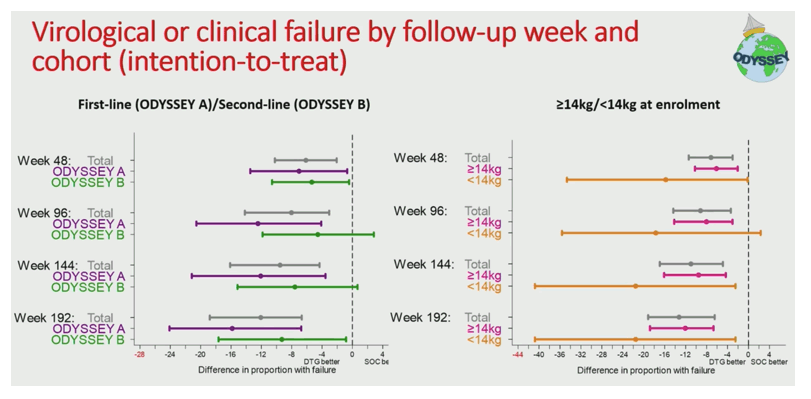 |
 |
 |
| |
ODYSSEY 192-Week Follow-Up Evidences Superior
Efficacy of DTG for Children on First/Second-Line ART
|
| |
| |
One Failure Prevented for Every 8 African/Thai Children Treated With DTG
CROI 2024 (Conference on Retroviruses and Opportunistic Infections), March 3-6, 2024, Denver
Mark Mascolini
For every 8 children treated with dolutegravir (DTG) as first- or second-line therapy in Africa or Thailand, 1 child avoided treatment failure, according to a 5.5-year analysis of 792 children with HIV [1]. Nearly all children originally randomized to standard antiretroviral therapy (ART) in ODYSSEY and completing extended follow-up, 99%, switched to DTG by week 192.
ODYSSEY began with 792 children from 3 months to less than 18 years old-383 of them starting first-line ART in ODYSSEY A and 409 starting second-line ART in ODYSSEY B. ODYSSEY A randomized 189 children to DTG and 194 to standard of care; ODYSSEY B randomized 203 children to DTG and 206 to standard of care. The primary endpoint in each part of ODYSSEY was virologic failure (confirmed viral load at or above 400 copies after week 36 or lack of virologic response by week 24 with an ART switch) or clinical failure (death or new or recurrent WHO stage 3 or 4 event).
Randomized follow-up continued until the last participant reached week 96. At that point researchers invited participants to continue extended follow-up, and 683 of 707 approached (97%) agreed. Total median follow-up stretched to 5.5 years (interquartile range 4.5 to 6).
At the baseline visit, median age stood at 11.4 years and ranged from 0.1 to 18 years. Just under half of the group (49%) was female, median weight stood at 29 kg (range 3.4 to 85 kg), and 28% had WHO stage 3 or 4 HIV infection, 31% CD4%<15%. In ODYSSEY A standard-of-care group, 81% took a nonnucleoside, 19% a boosted protease inhibitor, and 1% an integrase inhibitor. In the ODYSSEY B standard-of-care group, 96% took a boosted protease inhibitor, 3% a nonnucleoside, and 1% an integrase inhibitor.
At week 48, ODYSSEY tallied a 7% virologic or clinical failure rate with DTG versus 14% in the standard-of-care group. Failure rates at week 96 were 16% with DTG versus 25% with standard of care, 19% versus 29% at week 144, 20% versus 34% at week 192, and 21% versus 34% at week 240. The difference between the two groups reached 13.8% by week 240.
By the end of follow-up, 309 people in the standard-of-care group had switched to DTG, representing 99% of participants completing extended follow-up. Among 392 children randomized to DTG and 400 randomized to standard of care, numbers of severe WHO stage 3 events, WHO stage 4 events, and deaths did not differ significantly between the two groups. CD4 percent improved 1.3% more with DTG than with standard care at week 96 (just significant at P = 0.049) and improved 1.4% more with DTG at week 192 (no longer significant at P = 0.095).

SOC participants switching to DTG were virologically suppressed post-switch (ODYSSEY A 99%, B 88%), including those suppressed pre-switch.
Intention to treat analysis found no significant difference between DTG and standard of care at week 192 in serious adverse events, grade 3 or worse adverse events, or neurological adverse events. There was a trend toward fewer psychiatric adverse events with standard of care than DTG (8 versus 14 events in 5 vs 12 participants, P = 0.08) and significantly fewer ART-modifying adverse events with DTG than standard of care (8 versus 24 events in 7 vs 21 participants, P = 0.008). ODYSSEY investigators noted the small number of psychiatric adverse events in either group, nearly all of which occurred in the first 2 years of treatment.
Through 192 weeks in both ODYSSEY A and ODYSSEY B, total cholesterol remained consistently lower with DTG than with standard of care: -12 mg/dL, 95% CI -20 to -5, P = 0.001 in ODYSSEY A and -6 mg/dL, 95% CI -12 to -1, P = 0.03).
The ODYSSEY team believes their findings "strongly support transition of children to DTG-based regimens.....DTG performed better than SOC".
Reference
1. Mujuru HA, White EM, Kekitiinwa AR, et al. ODYSSEY 192-Week Follow-Up Evidences Superior Efficacy of DTG for Children on First/Second-Line ART. CROI 2024 (Conference on Retroviruses and Opportunistic Infections), March 3-6, 2024, Denver. Abstract 186.
|
| |
|
 |
 |
|
|